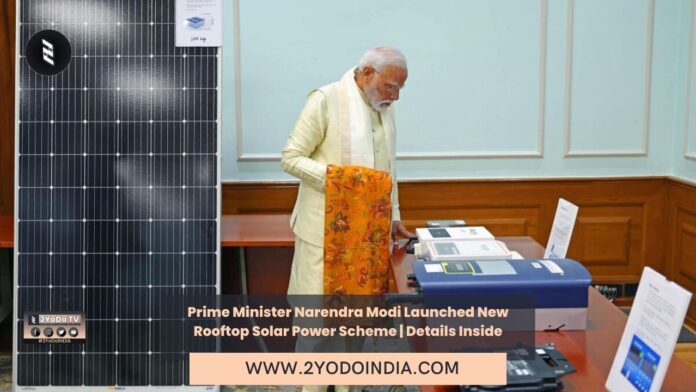PM Modi on 22nd January 2024 announce the ‘Pradhan Mantri Suryodaya Yojana’, a government scheme under which one crore households will get rooftop solar power systems.
In 2014, the government launch the Rooftop Solar Programme that aim to achieve a cumulative install capacity of 40,000 megawatts (MW) or 40 gigawatts (GW) by 2022, watt is a unit of power and is calculate as the amount of energy use over time, specifically one Joule per second.
But, this target couldn’t be achieve.
As a result, the government extend the deadline from 2022 to 2026.
The Pradhan Mantri Suryodaya Yojana seems to be a new attempt to help reach the target of 40 GW rooftop solar capacity.
What is Pradhan Mantri Suryodaya Yojana?
Mainly, it is a scheme that will involve installing solar power systems at rooftops for residential consumers.
In a post on X, PM Modi said:
“Today, on the auspicious occasion of the consecration of life in Ayodhya, my resolve has been further strengthened that the people of India should have their own solar rooftop system on the roof of their houses. The first decision I have taken after returning from Ayodhya is that our government will launch ‘Pradhanmantri Suryodaya Yojana’ with the target of installing rooftop solar on 1 crore houses.”
Prime Minister Narendra Modi said that the scheme would help not only reduce electricity bills of the “poor and middle class”, but also push India’s goal of becoming self-reliant in the energy sector.
India’s Current Solar Capacity
As per the Ministry of New and Renewable Energy’s website, solar power install capacity in India has reach around 73.31 GW as of December 2023.
While, rooftop solar install capacity is around 11.08 GW as of December 2023.
Rajasthan is at the top with 18.7 GW.
Gujarat is at the second position with 10.5 GW.
When it comes to rooftop solar capacity, Gujarat tops the list with 2.8 GW, follow by Maharashtra by 1.7 GW.
Solar power has a major share in the country’s current renewable energy capacity, which stands at around 180 GW.
What is Pradhan Mantri Suryodaya Yojana? 5 points about scheme PM Modi announced
— 2YoDoINDIA News Network (@2yodoindia) January 24, 2024
Details : https://t.co/GSag5P2i64
More News : https://t.co/98KV4yIruC#2YoDoINDIA #NarendraModi #PradhanMantriSuryodayaYojana #PrimeMinister #RooftopSolarPowerScheme #RooftopSolarProgramme pic.twitter.com/XNcjdGxgKG
Importance of Solar Energy in India
India is expect to witness the largest energy demand growth of any country or region in the world over the next 30 years, as per the latest World Energy Outlook by the International Energy Agency (IEA).
To meet the demand, India would need a reliable source of energy and it can’t be just coal plants.
Although India has double down on its coal production in recent years, it also aims to reach 500 GW of renewable energy capacity by 2030.
So, it is essential to expand solar power capacity, the country has increase it from less than 10 MW in 2010 to 70.10 GW in 2023.
Post by @2yodoindiaView on Threads
What is Rooftop Solar Programme?
This programme launch in 2014, the scheme aims to expand India’s rooftop solar install capacity in the residential sector by providing Central Financial Assistance, the financial assistance to the eligible projects as per MNRE Guidelines and incentives to DISCOMs (distribution companies).
This programme’s goal is to increase rooftop solar install capacity to 40 GM by March 2026 and it is currently in its second phase.
Owing to the scheme, the country’s rooftop solar has increase from 1.8 GW as of March 2019 to 10.4 GW as of November 2023.
People can avail of benefits of the scheme through DISCOM tender projects or through the National Portal, Minister of New and Renewable Energy RK Singh said in a written response to a query raised in Lok Sabha in 2023.
RK Singh said :
“On the National Portal, the consumer has the choice to select any vendor and choose the brand and quality/efficiency of solar equipment. The DISCOMs role is limited to issuing of technical feasibility approval, installation of net-meter and inspect the system,”.
After installation and inspection of the system, the subsidy is sent directly to the bank account of the consumer.




